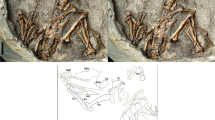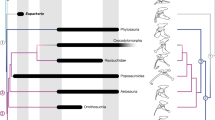Abstract
A nearly complete skeleton of Hyracotherium grangeri is described from the early Wasatchian (early Eocene) of the Clarks Fork Basin in northwestern Wyoming. This specimen includes a virtually complete, well-preserved pre-caudal vertebral column allowing the first thorough investigation of the locomotory abilities of these early Eocene horses. The posterior thorax (T) and lumbus (L) are divided into a facultatively dorsostable region (T15-L3) and an obligately dorsostable region (L3-L7). The facultatively dorsostable region is characterized by robust, cranially-oriented neural spines and well-developed attachment sites for epaxial musculature, whereas the obligately dorsostable region is characterized by embracing zygapophyses and less developed spines and attachment sites. Limb morphology exhibits a mixture of primitive characters and derived features associated with cursoriality. As described by previous authors, limb mobility is restricted at the elbow and ankle due to interlocking humero-radial and tibio-astragalar articulations, respectively. In contrast, the presence of a rounded femoral head and well-developed pelvic and femoral attachment sites for hindlimb adductor muscles suggests a highly mobile hip joint. Limited inversion of the manus and pes may have been possible via differential movement between the proximal and distal carpal elements and at the transverse tarsal joint, respectively. The obligately dorsostable region of the vertebral column likely resisted variably-oriented torque applied by hip musculature, thereby preventing dislocation of the pelvis and lumbus. The facultatively dorsostable region would have facilitated dynamic positioning of the center of mass during rapid acceleration. Brief comparisons with Orohippus and Mesohippus postcrania are used to discuss the selective pressures imposed by changes in body mass and habitat on the postcranial evolution of Paleogene horses.



















Similar content being viewed by others
References
Biewener AA (1989) Scaling body support in mammals: limb posture and muscle mechanics. Science 245:45–48
Budras KD (2009) Anatomy of the Horse. Schlutersche, Germany
Camp CL, Smith N (1942) Phylogeny and functions of the digital ligaments of the horse. Mem Univ Calif 13:69–124
Clauss M, Frey R, Kiefer B, Lechner-Doll M, Loehlein W, Polster C, Rossner GE, Streich WJ (2003) The maximum attainable body size of herbivorous mammals: morphophysiological constraints on foregut and adaptations of hindgut fermenters. Oecologia 136:14–27
Cope ED (1884) The Vertebrata of the Tertiary formations of the west. Report US Geol Survey Territories 3:1–1009
Evans HE (1993) Miller’s Anatomy of the Dog. Saunders, Philadelphia
Fife MM, Bailey CL, Lee DV, Carrier DR (2001) Function of the oblique hypaxial muscles in trotting dogs. J Exp Biol 204:2371–2381
Franzen JL (2010) The Rise of Horses: 55 million Years of Evolution. Johns Hopkins University Press, Baltimore
Froehlich DJ (1999) Phylogenetic systematics of basal perissodactyls. J Vertebr Paleontol 19:140–159
Froehlich DJ (2002) Quo vadis eohippus? The systematic and taxonomy of the early Eocene equids (Perissodactyla). Zool J Linn Soc 134:141–256
Gingerich PD (1981) Variation, sexual dimorphism, and social structure in the early Eocene horse Hyracotherium (Mammalia, Perissodactyla). Paleobiology 7:443–455
Gingerich PD (2003) Mammalian responses to climate change at the Paleocene-Eocene boundary: Polecat Bench record in the northern Bighorn Basin, Wyoming. In: Gingerich PD, Schmitz B, Thomas E, Wing SL (eds) Causes and Consequences of Globally Warm Climates in the Early Paleogene. Geol Soc Am Spec Pap 369:463–478
Gingerich PD (2006) Environment and evolution through the Paleocene-Eocene thermal maximum. Trends Ecol Evol 21:246–253
Gradstein FM, Ogg JG, Smith AG (2005) A Geologic Time Scale 2004. Cambridge University Press, Cambridge
Hildebrand M (1959) Motions of the running cheetah and horse. J Mammal 40:481–495
Holbrook LT (2001) Comparative osteology of early Tertiary tapiromorphs (Mammalia, Perissodactyla). Zool J Linn Soc 132:1–54
Hooker JJ (1994) The beginning of the equoid radiation. Zool J Linn Soc 112:29–63
Hussain ST (1975) Evolutionary and functional anatomy of the pelvic limb in fossil and recent Equidae (Perissodactyla, Mammalia). Anat Histol Embryol 4:179–222
Janis CM (1993) Tertiary mammal evolution in the context of changing climates, vegetation, and tectonic events. Annu Rev Ecol Syst 24:467–500
Janis CM, Wilhelm PB (1993) Were there mammalian pursuit predators in the Tertiary? Dances with wolf avatars. J Mammal Evol 1:103–125
Jenkins FA, McClearn D (1984) Mechanisms of hind foot reversal in climbing mammals. J Morphol 182:197–219
Kappelman J (1988) Morphology and locomotor adaptations of the bovid femur in relation to habitat. J Morphol 198:119–130
Kitts DB (1956) American Hyracotherium (Perissodactyla, Equidae). Bull Am Mus Nat Hist 110:1–60
Kitts DB (1957) A revision of the genus Orohippus (Perissodactyla, Equidae). Am Mus Novitates 1864:1–40
Licka TF, Peham C, Frey A (2004) Electromyographic activity of the longissimus dorsi muscles in horses during trotting on a treadmill. Am J Vet Res 65:155–158
MacFadden BJ (1986) Fossil horses from “Eohippus” (Hyracotherium) to Equus: scaling, Cope’s law, and the evolution of body size. Paleobiology 12:355–369
MacFadden BJ (1992) Fossil Horses: Systematics, Paleobiology, and Evolution of the Family Equidae. Cambridge University Press, Cambridge
Miyata K (ed) (2008) Extinction of Dinosaurs and Rise of New Rulers. Fukui Prefectural Dinosaur Museum, Japan
Owen R (1841) Descriptions of the fossil remains of a mammal (Hyracotherium leporinum) and of a bird (Lithornis vulturinus) from the London Clay. Trans Geol Soc Lond 6:203–208
Radinsky L (1966) The adaptive radiation of the phenacodontid condylarths and the origin of the Perissodactyla. Evolution 20:408–417
Rose KD (1996) Skeleton of early Eocene Homogalax and the origin of Perissodactyla. Palaeovertebrata 25:243–260
Rose KD (2006) The Beginning of the Age of Mammals. Johns Hopkins University Press, Baltimore
Schilling N, Carrier DR (2009) Function of the epaxial muscles during trotting. J Exp Biol 212:1053–1063
Schilling N, Fischbein T, Yang EP, Carrier DR (2009) Function of the extrinsic hindlimb muscles in trotting dogs. J Exp Biol 212:1036–1052
Scott WB (1891) On the osteology of Mesohippus and Leptomeryx with observations on the modes and factors of evolution in the Mammalia. J Morphol 5:301–406
Secord R, Wing SL, Chew A (2008) Stable isotopes in early Eocene mammals as indicators of forest canopy structure and resource partitioning. Paleobiology 34:282–300
Slijper EJ (1946) Comparative biologic-anatomical investigations on the vertebral column and spinal musculature of mammals. Verh Konink Nederland Akad Wetenschap, Twede Sectie 42:1–128
Solounias N, Semprebon G (2002) Advances in the reconstruction of ungulate ecomorphology with application to early fossil equids. Am Mus Novitates 3366:1–49
Steudel K (1990) The work and energetic cost of locomotion. I. The effects of limb mass distribution in quadrupeds. J Exp Biol 154:273–285
Taylor StCS, Murray JI (1987) Genetic aspects of mammalian survival and growth in relation to body size. In: Hacker JB, Ternouth JH (eds) The Nutrition of Herbivores. Academic Press, Orlando, pp 487–533
Walter RM, Carrier DR (2007) Ground forces applied by galloping dogs. J Exp Biol 210:208–216
Walter RM, Carrier DR (2009) Rapid acceleration in dogs: ground forces and body posture dynamics. J Exp Biol 212:1930–1939
Woodburne MO, Gunnell GF, Stucky RK (2009) Land mammal faunas of North America rise and fall during the Early Eocene Climatic Optimum. Denver Mus Nat Sci Ann 1:1–74
Zhou X, Sanders WJ, Gingerich PD (1992) Functional and behavioral implications of the vertebral structure in Pachyaena ossifraga (Mammalia, Mesonychia). Contrib Mus Paleontol Univ Mich 28:289–319
Acknowledgments
We thank W. Sanders for guidance during the preparation and initial analysis of UM 115547. We also thank D. Hensley for his assistance during the collection of UM 115547, G. Gunnell for help using the University of Michigan Museum of Paleontology collections, and B. Miljour for preparation of Fig. 1. Discussions with T. Baumiller, A. Rountrey, and K. Smith were helpful in organizing earlier versions of the manuscript. The field season in which UM 115547 was collected was funded by the Petroleum Research Fund of the American Chemical Society (46858-AC8).
Author information
Authors and Affiliations
Corresponding author
Rights and permissions
About this article
Cite this article
Wood, A.R., Bebej, R.M., Manz, C.L. et al. Postcranial Functional Morphology of Hyracotherium (Equidae, Perissodactyla) and Locomotion in the Earliest Horses. J Mammal Evol 18, 1–32 (2011). https://doi.org/10.1007/s10914-010-9145-7
Published:
Issue Date:
DOI: https://doi.org/10.1007/s10914-010-9145-7




